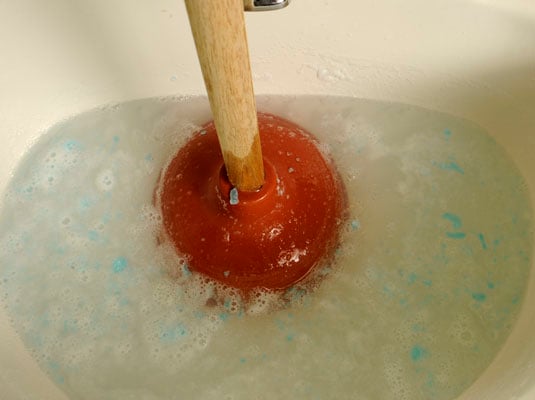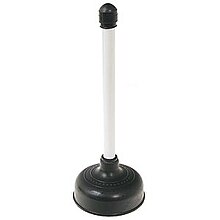Applying Plungers and Drain Cleaners: Best Practices
Applying Plungers and Drain Cleaners: Best Practices
Blog Article
Almost everyone seems to have their own individual assumption when it comes to How To Use Your Toilet Plunger Correctly in 5 Easy Steps.

Introduction
Appropriate upkeep of household drains is crucial for protecting against obstructions and guaranteeing smooth water circulation. One of the secret tools in every property owner's toolkit is the bettor, together with numerous drain cleaners made to take on persistent obstructions properly. This post explores how to utilize plungers and drainpipe cleansers successfully to maintain your drains moving easily.
Section 1: Understanding Bettors
Sorts of Plungers
There are numerous sorts of bettors readily available, each made for various sorts of drains pipes and obstructs. One of the most typical types consist of cup plungers, flange plungers, and accordion bettors.
Just How Plungers Work
Bettors work on the concept of creating stress and suction to remove blockages. When appropriately used over a drainpipe, they produce a vacuum that can pull out debris or break up obstructions.
Choosing the Right Bettor
Selecting the right plunger depends upon the type of drain and the nature of the obstruction. Cup plungers are suitable for sinks and tubs, while flange bettors are better fit for commodes due to their layout.
Usual Errors with Bettors
Avoiding these errors ensures efficient plunging: improper seal around the drain, insufficient force, and not clearing bordering debris.
Area 2: Using Plungers Effectively
Preparation
Before diving, make sure the bettor covers the drain entirely and develops a tight seal. Clear any visible debris around the drain opening.
Method
Start with mild diving movements to build suction. Increase pressure gradually, utilizing a steady rhythm. Repeat as needed until the drainpipe removes.
Fixing Tips
If plunging doesn't function, attempt readjusting the seal, using petroleum jelly for a better seal, or making use of a various sort of plunger.
Section 3: Understanding Drainpipe Cleaners
Types of Drainpipe Cleansers
Drain cleaners can be chemical or chemical. Chemical cleansers make use of solid chemicals to dissolve clogs, while chemical cleaners use all-natural enzymes to break down raw material.
Exactly How Drainpipe Cleansers Work
Chemical cleansers react with obstructions to dissolve them, while enzymatic cleaners break down organic products like hair and oil without hurting pipelines.
Safety and security Considerations
Constantly use handwear covers and eye protection when using chemical drainpipe cleaners. Make sure ample ventilation and comply with manufacturer instructions meticulously.
Eco-Friendly Alternatives
Take into consideration utilizing vinegar and baking soda or enzyme-based cleansers for green options that are more secure for pipes and the setting.
Area 4: Using Drainpipe Cleaners Effectively
Application Strategies
Put chemical cleansers directly right into the drain opening. Permit them to benefit the advised time before flushing with hot water. Chemical cleaners need to rest overnight.
Precautions
Prevent mixing various types of cleaners, as this can generate hazardous fumes. Never use chemical cleansers together with a plunger, as spilling can happen.
Managing Stubborn Blockages
For persistent blockages, consider making use of a pipes snake or calling an expert plumbing to avoid damage to pipes.
Conclusion
Finally, recognizing how to utilize bettors and drain cleansers properly is necessary for preserving healthy and balanced pipes systems. By picking the right devices and methods, property owners can tackle small clogs and prevent major plumbing issues down the line.
How To Properly Use A Plumbing Snake To Clear Drains
When any drain clogs in our home arise, we tend to gravitate toward the plunger and little else. In cases where the plunger and its vacuum-created pressure are not able to clear clogs, many immediately move to harmful chemicals or simply call their plumber to fix the issue.
we’re happy to help with all drain cleaning needs and concerns. This includes informing you on a few other home remedies you may have at your disposal for minor to moderate clogs, one of which is the use of a plumbing snake. Many people have never used one of these before – let’s go over the steps to take when your drain clogs and you have a plumbing snake available.
Attempt Plunger Use
The first step here, as we noted above, should indeed be to grab your plunger when you notice a drain clog and attempt to resolve it this way. If you’re unsure how to use a particular type of plunger, our plumbers can answer any questions you have. If this doesn’t do the trick, however, you move on to the snake.
Locate And Prepare Snake
A plumbing snake is a metal or plastic device that’s generally about a quarter of an inch thick. It’s design with significant extensions, meant to reach down into your clogged drain and push the clog out. Snakes also contain drain augers that will latch onto and push stubborn blockages.
If your plunger doesn’t clear a clog, locate your snake and bring it to the drain in question. We also recommend keeping a bucket nearby to collect the clog once you pull it out, plus we’d advise wearing goggles and possibly protective gloves.
Feed Snake
Once you’re ready to go, feed the snake slowly down the drain, using the crank device it comes with to keep it moving until it finds the clog. Once this happens, much of the clog will be latched onto the coil so you can pull it out, while the rest will simply break up and flow downward.
Detach Debris
Remove the snake slowly from the drain, and once you’ve done so, pick off any debris that’s stuck to the coil. This is another area where wearing gloves is a must.
Flush Drain
Finally, take a few minutes to ensure the snake has done its job correctly. If you’ve been using it on a toilet, flush the toilet a couple times and make sure everything flows well. If you’ve used it on a different drain, flush it with some room temperature water.
https://www.mybuddytheplumber.com/blog/how-to-properly-use-a-plumbing-snake-to-clear-drains/

Application Strategies
Put chemical cleansers directly right into the drain opening. Permit them to benefit the advised time before flushing with hot water. Chemical cleaners need to rest overnight.
Precautions
Prevent mixing various types of cleaners, as this can generate hazardous fumes. Never use chemical cleansers together with a plunger, as spilling can happen.
Managing Stubborn Blockages
For persistent blockages, consider making use of a pipes snake or calling an expert plumbing to avoid damage to pipes.
Conclusion
Finally, recognizing how to utilize bettors and drain cleansers properly is necessary for preserving healthy and balanced pipes systems. By picking the right devices and methods, property owners can tackle small clogs and prevent major plumbing issues down the line.
How To Properly Use A Plumbing Snake To Clear Drains
When any drain clogs in our home arise, we tend to gravitate toward the plunger and little else. In cases where the plunger and its vacuum-created pressure are not able to clear clogs, many immediately move to harmful chemicals or simply call their plumber to fix the issue.
we’re happy to help with all drain cleaning needs and concerns. This includes informing you on a few other home remedies you may have at your disposal for minor to moderate clogs, one of which is the use of a plumbing snake. Many people have never used one of these before – let’s go over the steps to take when your drain clogs and you have a plumbing snake available.
Attempt Plunger Use
The first step here, as we noted above, should indeed be to grab your plunger when you notice a drain clog and attempt to resolve it this way. If you’re unsure how to use a particular type of plunger, our plumbers can answer any questions you have. If this doesn’t do the trick, however, you move on to the snake.
Locate And Prepare Snake
A plumbing snake is a metal or plastic device that’s generally about a quarter of an inch thick. It’s design with significant extensions, meant to reach down into your clogged drain and push the clog out. Snakes also contain drain augers that will latch onto and push stubborn blockages.
If your plunger doesn’t clear a clog, locate your snake and bring it to the drain in question. We also recommend keeping a bucket nearby to collect the clog once you pull it out, plus we’d advise wearing goggles and possibly protective gloves.
Feed Snake
Once you’re ready to go, feed the snake slowly down the drain, using the crank device it comes with to keep it moving until it finds the clog. Once this happens, much of the clog will be latched onto the coil so you can pull it out, while the rest will simply break up and flow downward.
Detach Debris
Remove the snake slowly from the drain, and once you’ve done so, pick off any debris that’s stuck to the coil. This is another area where wearing gloves is a must.
Flush Drain
Finally, take a few minutes to ensure the snake has done its job correctly. If you’ve been using it on a toilet, flush the toilet a couple times and make sure everything flows well. If you’ve used it on a different drain, flush it with some room temperature water.
https://www.mybuddytheplumber.com/blog/how-to-properly-use-a-plumbing-snake-to-clear-drains/

Do you enjoy reading about How To Use Your Toilet Plunger Correctly in 5 Easy Steps? Put a comment directly below. We will be happy to find out your ideas about this article. We hope that you visit us again before long. Are you aware of another individual who is sincerely interested in How to Use a Plunger to Unclog a Toilet or Drain? Why not share it. Kudos for being here. Return soon.
Schedule Today! Report this page